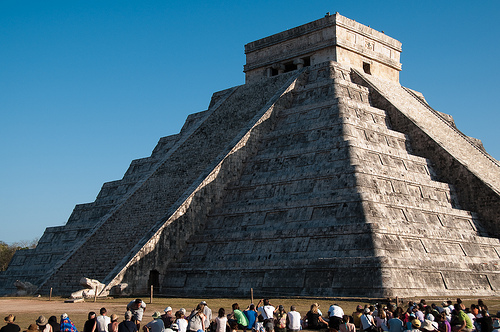The main pyramid at the Maya site of Chichen Itza in the Yucatán Peninsula is the most popular site in Mexico for crowds to gather and celebrate the Spring Equinox (March 20-21). The Maya were accomplished astronomers and were able to accurately predict equinoxes, eclipses and other celestial events hundreds of years in advance.
The main pyramid at Chichen Itza, known as the Pyramid of Kukulkan, has some unusual properties which researchers are still trying to explain. It is so precisely aligned that for a day or two either side of the Spring Equinox, the light falling on one side of the pyramid creates undulating shadows that look like a serpent slithering down the pyramid steps. The effect is best seen between 4 and 5 pm.
The slithering serpent is not the only surprise that the Pyramid of Kukulkan has in store for visitors. Kukulkan was a Mayan deity, the “feathered serpent”, more usually known in central Mexico as Quetzalcoatl. The Pyramid of Kukulkan is linked to the quetzal bird, because depictions of Kukulkan often show the distinctively long feathers of the quetzal. Standing in front of the pyramid and making a single hand clap results in an echo from the pyramid’s staircase, an echo which sounds like the downward chirp of a quetzal bird.
David Lubman has proposed that this may be the earliest sound recording so far discovered anywhere on the planet. We may never know whether it was originally accidental or intentional, but Lubman makes a strong case for this chirp being a deliberate representation of the call of the Respendant Quetzal bird, a bird described in Peterson and Chalif’s Field Guide to Mexican Birds as “the most spectacular bird in the New World.” Quetzal birds were sacred to the Maya, and their feathers were highly prized; the birds were formerly common in the rainforest which originally cloaked this entire region.
Sources
Original article on MexConnect.com: Did you know? Mayan architects built world’s oldest sound recordings
Lubman, David (1998) “Archaeological acoustic study of chirped echo from the Mayan pyramid at Chichen Itza, in the Yucatan Region of Mexico… Is this the world’s oldest known sound recording?“. Paper presented to the 136th Meeting of the Acoustical Society of America, October 1998.
Lubman, David (2002) “More on the Mayan Pyramid“. Article on the website of the Orange County Regional Chapter of the Acoustical Society of America:

Sorry, the comment form is closed at this time.